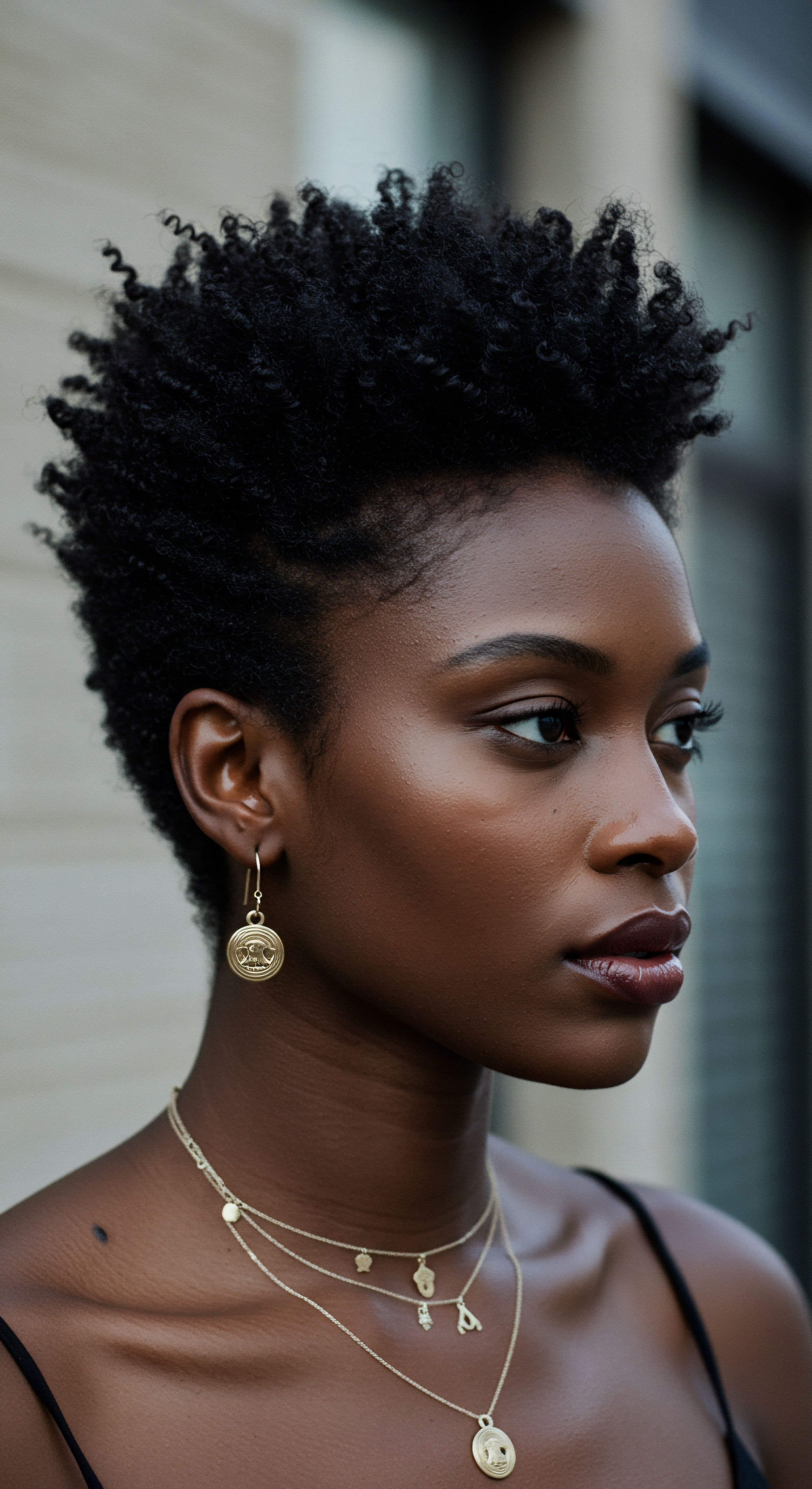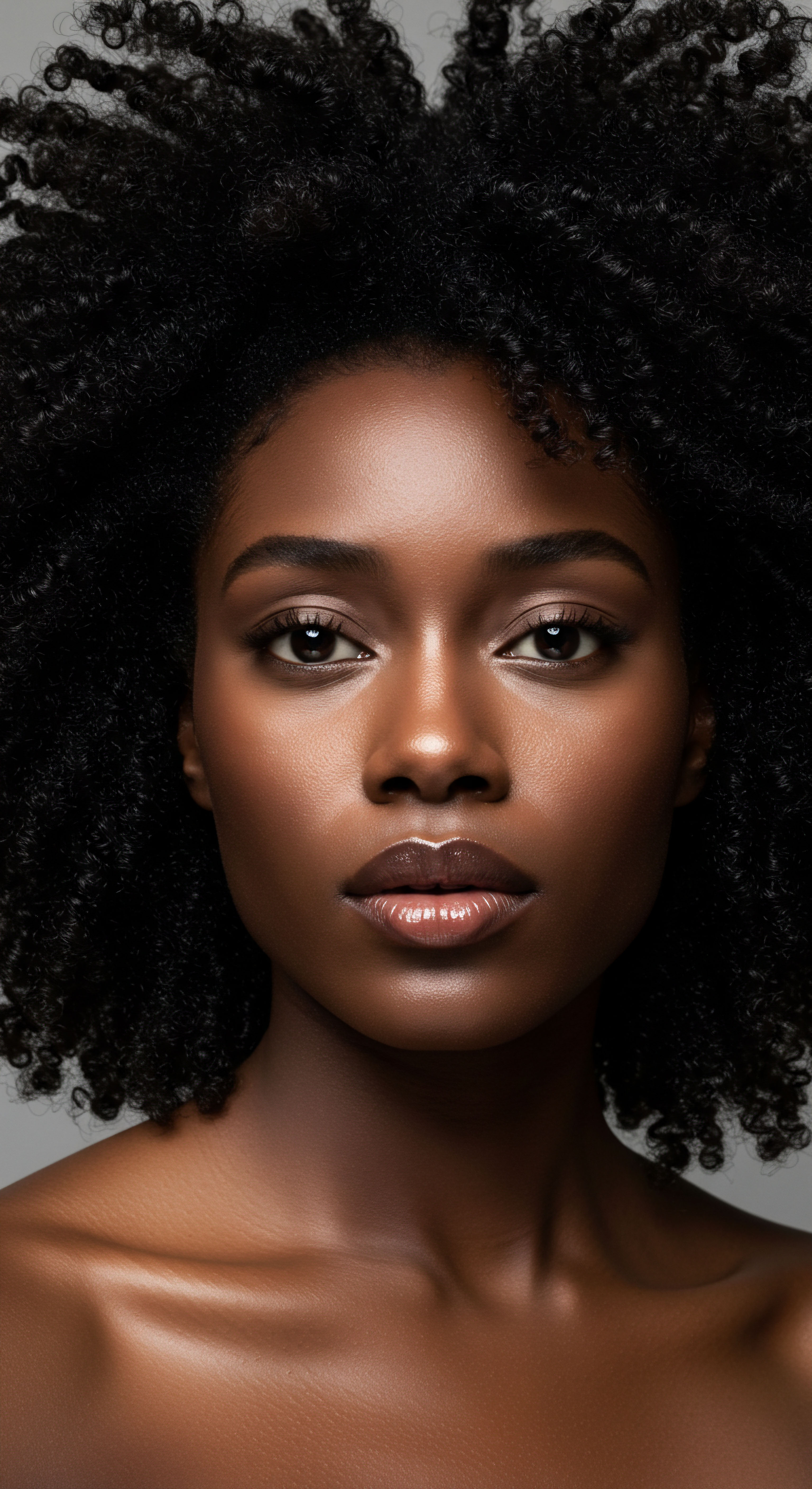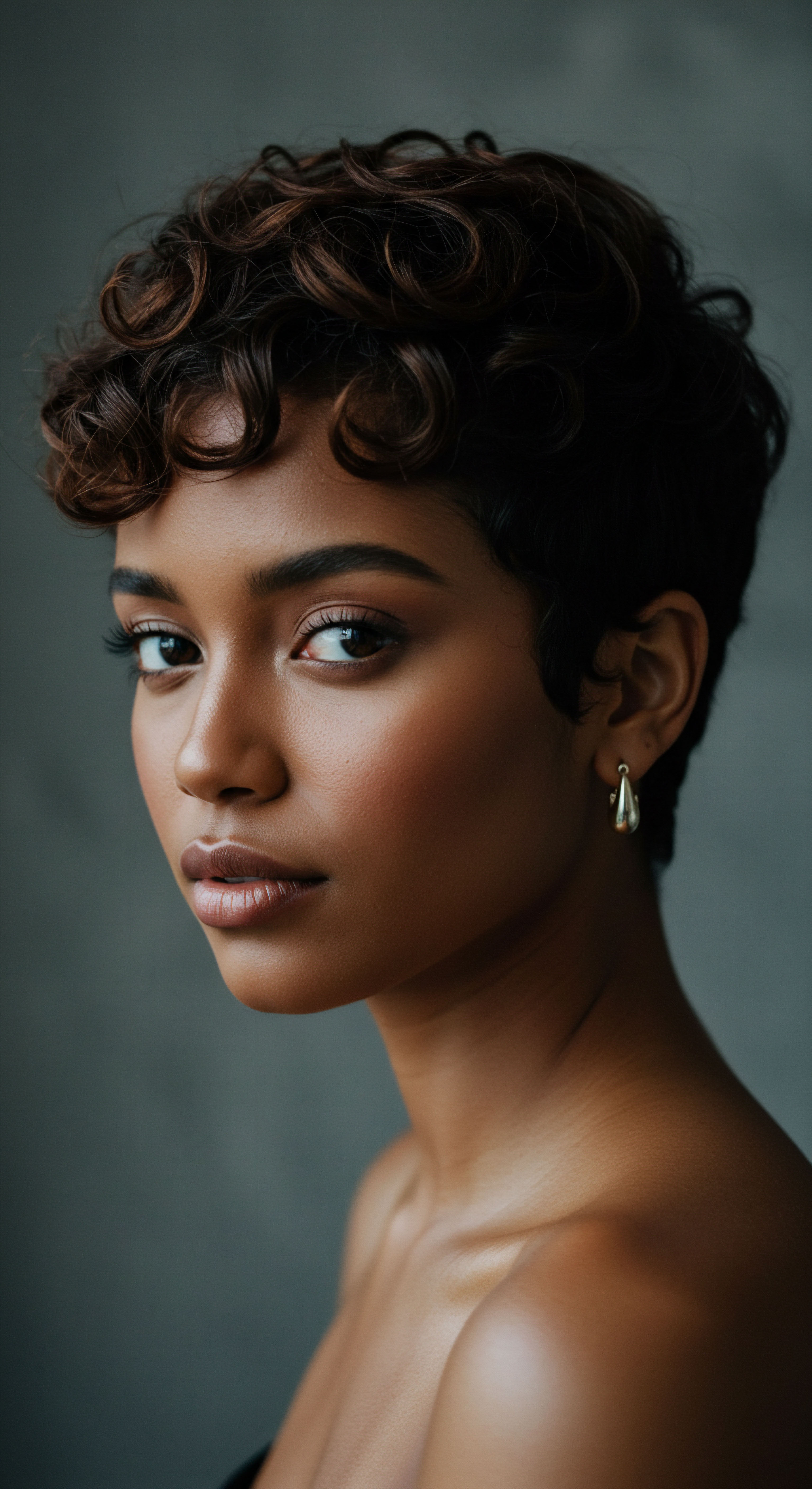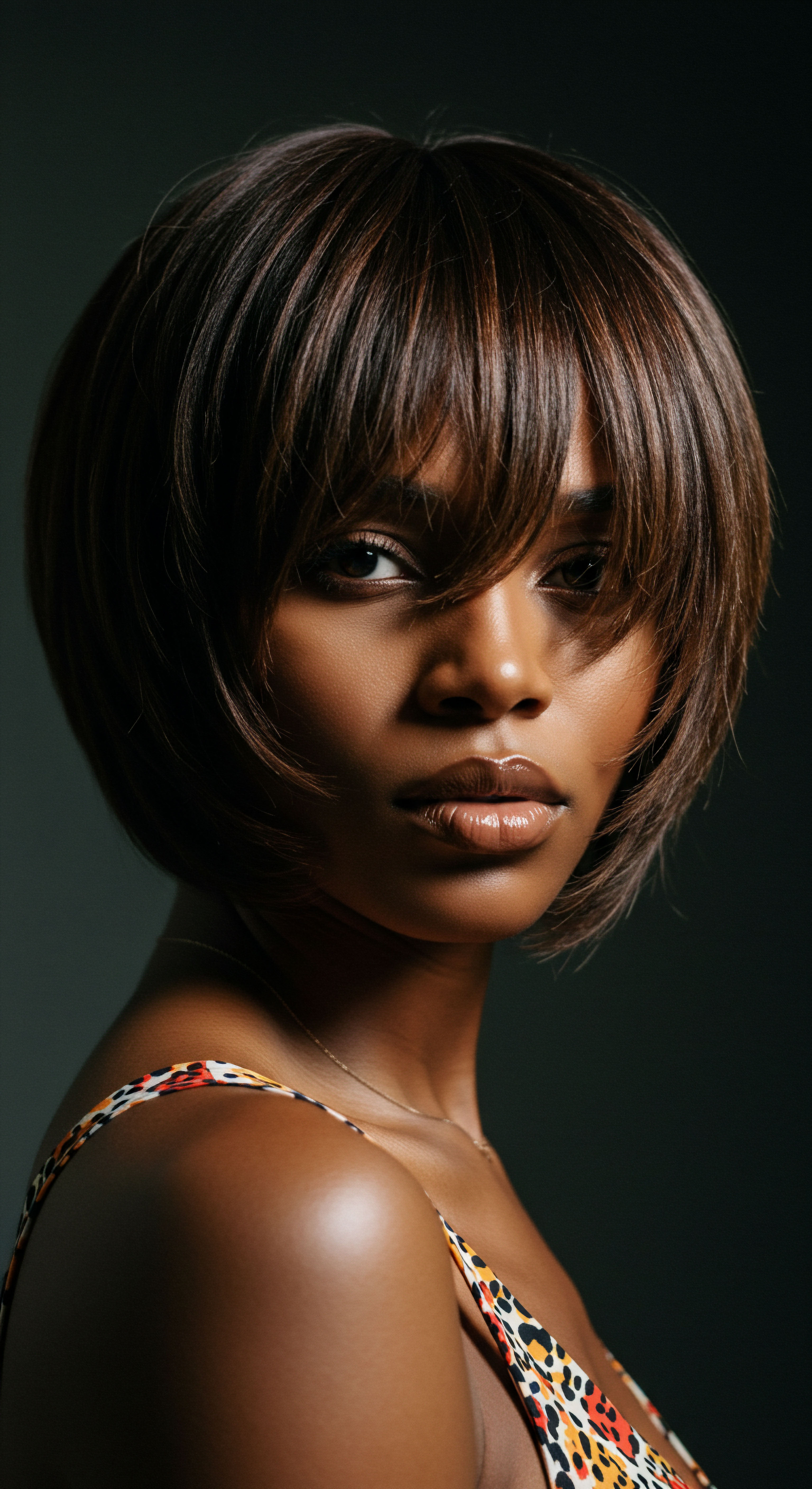
Fundamentals
The very essence of a healthy, vibrant strand of hair, particularly within the diverse landscape of textured tresses, resides deeply within its core ❉ the Hair Cortex Structure. To truly appreciate the magnificent resilience and unique character of coily, curly, and wavy hair, understanding this internal architecture becomes a foundational step. This layer, a central pillar of each individual hair shaft, offers far more than simple support; it orchestrates the physical attributes we observe and cherish. It is the primary interior component, nestled beneath the protective outer cuticle and, in many cases, enveloping the innermost medulla.
Consider the hair cortex as the grand chamber where the hair’s most significant qualities are determined. Here, a complex network of proteins, primarily Keratin, forms the very framework of the hair fiber. These robust proteins, the same found in our skin and nails, are organized into a hierarchical system, lending hair its remarkable strength and the ability to stretch and return to its original form. The cortex represents the bulk of the hair’s mass, often accounting for approximately 80% of its total weight, making its integrity paramount for overall hair health and appearance.
Within this substantial layer, the hair’s natural pigmentation also finds its home. Tiny granules of Melanin, the biological pigment responsible for color in skin and eyes, are dispersed throughout the cortical cells. These pigments, primarily eumelanin (contributing to brown and black hues) and pheomelanin (responsible for red and yellow tones), combine in varying concentrations and distributions to paint the vast spectrum of natural hair colors we witness across humanity. The presence and arrangement of these color-imparting elements directly influence how light interacts with the hair, contributing to its inherent luster and depth of shade.
The hair cortex, a central and robust internal layer, is the primary determinant of a strand’s strength, elasticity, and natural color.

Architectural Elements of the Cortex
The structural integrity of the hair cortex is a marvel of biological engineering, relying on the precise arrangement of its fundamental constituents. At its core, the cortex comprises elongated, spindle-shaped cells that align themselves parallel to the hair’s longitudinal axis. These cells, typically ranging from 1 to 6 micrometers in diameter and 50 to 100 micrometers in length, are densely packed with the aforementioned keratin proteins.
- Keratin Proteins ❉ These fibrous, cysteine-rich proteins constitute the primary building blocks of the hair cortex. They belong to the intermediate filament protein superfamily, signifying their role in providing structural support and mechanical stability.
- Intermediate Filaments (IFs) ❉ Formed from the coiling together of alpha-helical keratin protein chains, these filaments represent a critical level of organization within the cortex. Seven to ten pairs of protofilaments, themselves coiled-coil dimers of type I (acidic) and type II (neutral) keratins, assemble to create these intermediate filaments.
- Macro-Fibrils ❉ These larger bundles of intermediate filaments, embedded within an amorphous matrix of keratin-associated proteins (KAPs), constitute the basic units of the cortical cell. The KAPs, rich in cysteine, help cross-link the keratin filaments, contributing to the rigidity and overall mechanical strength of the hair fiber.

The Language of Bonds ❉ Shaping and Sustaining
The physical properties of hair, including its shape, strength, and elasticity, are intrinsically linked to the chemical bonds that hold these cortical proteins together. These bonds are not merely static connections; they are dynamic forces that respond to environmental cues and chemical treatments, allowing for the remarkable adaptability of hair.
Among the most significant are Disulfide Bonds, powerful covalent linkages formed between sulfur atoms of cysteine amino acids present in the keratin chains. These strong, permanent bonds are largely responsible for defining the hair’s inherent shape—whether straight, wavy, curly, or coily. The distribution and density of these bonds within the cortex play a profound role in establishing the natural curl pattern. Altering these bonds, as in chemical perms or relaxers, fundamentally reshapes the hair.
Complementing these robust connections are Hydrogen Bonds and Salt Bonds. Hydrogen bonds, while considerably weaker than disulfide bonds, are abundant and collectively contribute significantly to hair’s strength, accounting for approximately one-third of its overall resilience. These temporary bonds are easily disrupted by water and heat, which explains why hair changes shape when wet or styled with heat, only to revert to its natural form upon drying or cooling.
Salt bonds, also temporary and sensitive to pH fluctuations, similarly contribute to hair’s strength and elasticity. The interplay of these varied bonds provides the hair with its remarkable balance of durability and flexibility.

Intermediate
Moving beyond the fundamental composition, an intermediate understanding of the hair cortex reveals its active participation in the daily life of textured hair, influencing everything from moisture retention to styling responsiveness. The cortex is not a passive structure; it is a dynamic participant in the hair’s journey, absorbing and releasing moisture, and responding to the nuances of its environment. For individuals with textured hair, this deeper comprehension illuminates the unique considerations necessary for optimal care and healthy growth.
The cortical layer’s capacity for water uptake is a direct determinant of hair’s moisture balance and flexibility. When the hair cuticle, the outermost protective layer, is raised or compromised, the cortex becomes more exposed, allowing for greater absorption or loss of moisture. This relationship between the cuticle and cortex is particularly pertinent for textured hair, which often exhibits a more open or irregularly shaped cuticle, leading to a higher propensity for dryness and challenges with moisture retention. Understanding this dynamic interaction empowers us to select products and practices that support the cortex’s hydration needs.

Cortical Cells and Curl Patterns ❉ A Closer Look
The distinctive curl patterns inherent to textured hair types find their origins not solely in the shape of the hair follicle, but also in the specific arrangement of cells within the cortex itself. While straight hair tends to display a symmetrical distribution of cortical cell types, curly and coily hair exhibits a remarkable asymmetry.
Within the cortex, two primary cell types, the Orthocortex and Paracortex, are distributed bilaterally. In textured hair, the orthocortex is typically concentrated on the external portion of the curl, while the paracortex resides on the internal curve. This uneven distribution of cellular components is a significant factor in how the hair fiber bends and maintains its characteristic spiral or S-shape. The internal packing arrangements of intermediate filaments within these cell types differ, contributing to the hair’s inherent curvature.
The distinctive curl of textured hair is profoundly influenced by the asymmetrical arrangement of orthocortex and paracortex cells within the hair’s central cortical layer.

Melanin’s Dual Role ❉ Color and Protection
Beyond simply imparting color, the melanin housed within the hair cortex also plays a protective role. These pigments absorb and dissipate ultraviolet (UV) rays, helping to shield the cortical proteins from potential damage caused by sun exposure. This natural defense mechanism is an intrinsic aspect of the hair’s resilience.
The concentration and distribution of eumelanin and pheomelanin within the cortex influence not only the hair’s hue but also its response to light. Hair with a higher concentration of pigment, often darker shades, tends to absorb more light, yielding a richer, more saturated appearance. Conversely, lighter hair, with a predominance of pheomelanin, reflects more light, creating distinct highlights and a luminous quality. Recognizing this interplay allows for a deeper appreciation of the hair’s natural beauty and its inherent protective capabilities.

Cortex and Hair’s Mechanical Behavior
The cortex is the principal contributor to the hair’s mechanical properties, dictating its strength, elasticity, and resistance to breakage. The ability of a hair strand to stretch without breaking, a property known as tensile strength, is directly related to the integrity and organization of the keratin network within the cortex. When the cortical structure is compromised, perhaps through excessive heat, chemical treatments, or mechanical stress, the hair can become brittle, lose its elasticity, and be more prone to fracture.
For textured hair, the unique helical and spiral geometry, a direct consequence of the cortical cell distribution and disulfide bond density, introduces specific mechanical considerations. While Afro-textured hair possesses a higher density of disulfide bonds, which are typically associated with strength, its high curvature paradoxically renders it more vulnerable to mechanical extension and breakage. This is because the curved shape creates points of weakness and stress concentration along the fiber. Understanding this delicate balance informs gentle handling practices and the selection of products designed to reinforce the hair’s inherent structure.
| Aspect of Cortex Cross-Sectional Shape |
| General Hair Typically round to oval. |
| Textured Hair Specifics More elliptical, contributing to coil patterns. |
| Aspect of Cortex Cortical Cell Distribution |
| General Hair Often symmetrical. |
| Textured Hair Specifics Bilateral distribution of orthocortex (external curl) and paracortex (internal curl). |
| Aspect of Cortex Disulfide Bond Density |
| General Hair Varies by hair type. |
| Textured Hair Specifics Often a higher density, yet can be more prone to breakage due to curvature. |
| Aspect of Cortex Moisture Retention |
| General Hair Influenced by cuticle and cortex integrity. |
| Textured Hair Specifics Can be more challenging due to cuticle characteristics and lipid distribution, despite higher lipid content. |

Advanced
The advanced interpretation of the Hair Cortex Structure transcends a mere biological delineation, extending into a comprehensive understanding of its profound significance for textured hair within scientific, cultural, and socio-historical frameworks. This deeper analysis reveals the cortex as a complex, dynamic system, whose molecular intricacies and morphological expressions are inextricably linked to the lived experiences, heritage, and care rituals of individuals with Black and mixed-race hair. It is here that we move beyond simple explanation to a nuanced elucidation of the cortex’s enduring implications.
At an expert level, the hair cortex represents the primary site of hair’s anisotropic mechanical properties, meaning its physical characteristics vary depending on the direction of applied force. This anisotropy is especially pronounced in highly textured hair, where the elliptical cross-section and the asymmetric distribution of cortical cell types — specifically the Orthocortex and Paracortex — dictate how the hair responds to tension, compression, and torsion. The orthocortex, with its lower density and higher intermediate filament content, and the paracortex, characterized by a denser matrix and more cross-links, behave differently under stress. This differential response within a single fiber contributes to the intrinsic coiling, yet simultaneously creates areas of heightened mechanical vulnerability along the curl’s apex and curves.

The Paradox of Strength and Vulnerability in Textured Hair Cortex
A particularly compelling, and perhaps counterintuitive, insight in hair science concerns the disulfide bond content in textured hair. Research indicates that Afro-textured hair often exhibits a higher density of these strong, permanent chemical bonds compared to straight hair. Conventionally, a greater number of disulfide bonds implies increased structural rigidity and strength. However, the macro-structural reality of highly curved hair introduces a fascinating paradox.
The inherent curvature of the hair fiber, a direct manifestation of the asymmetrical cortical cell arrangement, imposes continuous strain on these very bonds. This constant mechanical bending creates localized stress points, rendering the hair more susceptible to breakage despite its chemically robust internal network.
This structural predisposition means that textured hair, while possessing a formidable internal architecture, requires specialized care strategies to mitigate external stressors. The implication for product development and hair care regimens is substantial ❉ formulations must not only fortify the keratin matrix but also address the unique biomechanical forces acting upon the curved fiber. This deeper understanding moves beyond generic “moisture vs. protein” debates to a more precise, biomechanics-informed approach to textured hair health.
Despite a higher density of disulfide bonds, the pronounced curvature of textured hair introduces inherent stress points, making it more prone to breakage than its straight counterparts.

The Cortex as a Gateway ❉ Penetration and Permeability
The cortical layer’s role extends to its permeability, a factor of immense consequence for the efficacy of hair care products and chemical treatments. The varying densities and compositions of the orthocortex and paracortex influence how molecules, such as water, oils, and active ingredients, penetrate the hair shaft. Studies have shown that the orthocortex, being less dense, allows for more ready diffusion of molecules, whereas the denser paracortex offers greater resistance.
This differential permeability within the cortex of textured hair leads to an uneven distribution of absorbed substances. For instance, a 2025 study revealed that while oils diffuse more uniformly in straight hair due to its homogeneous cortical structure, textured hair’s unique bilateral cortical arrangement creates distinct diffusion zones, resulting in inconsistent oil penetration and varied mechanical effects. This scientific observation clarifies why certain oil treatments or conditioning agents might perform unevenly on a single strand of textured hair, leading to localized areas of dryness or uneven product build-up. This advanced understanding necessitates a rethinking of application methods and ingredient selection for textured hair, favoring approaches that account for this internal heterogeneity.

Cultural Resonance and Scientific Delineation
The Hair Cortex Structure, particularly within the context of Black and mixed-race hair, cannot be fully appreciated without acknowledging its profound cultural and historical significance. Historically, Black hair has served as a powerful symbol of identity, social status, and resistance, often subjected to Eurocentric beauty standards that pathologized its natural textures. The very structure of the cortex, with its unique curl patterns, became intertwined with societal perceptions, leading to practices aimed at altering its natural form through chemical relaxers that fundamentally disrupt disulfide bonds within the cortex.
The contemporary natural hair movement, a resurgence of pride in inherent textures, represents a cultural reclaiming of the hair cortex’s natural design. This movement, rooted in a deeper appreciation for the hair’s biological blueprint, encourages practices that work harmoniously with, rather than against, the cortex’s unique properties. This societal shift highlights a collective yearning for a holistic understanding of hair that honors both its scientific realities and its deeply personal and collective meanings. The scientific community’s increasing focus on the distinct properties of textured hair’s cortex is a direct response to this cultural imperative, aiming to develop solutions that genuinely serve the needs of diverse hair types.

Long-Term Implications and Advanced Care Paradigms
From an advanced perspective, understanding the hair cortex informs long-term hair health strategies, moving beyond superficial treatments to foundational care. The constant mechanical stress on the cortex of textured hair, coupled with its often higher porosity and unique lipid distribution, predisposes it to chronic dehydration and fatigue. This understanding suggests that long-term success in textured hair care hinges on continuous reinforcement of the cortical integrity and proactive moisture management.
Advanced care paradigms for textured hair, therefore, emphasize:
- Targeted Protein Fortification ❉ Given the constant strain on disulfide bonds, strategic application of hydrolyzed proteins and amino acid complexes can help reinforce the keratin network within the cortex, providing internal scaffolding.
- Adaptive Hydration Protocols ❉ Recognizing the uneven permeability of the cortex, moisture delivery systems need to be designed to ensure uniform saturation and sustained hydration, possibly through smaller molecular weight humectants and emollients that can penetrate the denser paracortex regions.
- Minimizing Mechanical Stress ❉ Implementing low-manipulation styling, protective styles, and gentle detangling techniques becomes paramount to preserve the delicate cortical structure and prevent cumulative damage.
- PH-Balanced Formulations ❉ Maintaining the optimal pH environment is critical for preserving salt bonds within the cortex, contributing to overall hair strength and resilience.
The Hair Cortex Structure is thus not merely a biological component; it is a profound indicator of hair health, a canvas for cultural expression, and a scientific frontier for tailored care. Its comprehensive explication provides invaluable insights for researchers, product developers, and individuals seeking to cultivate the enduring vitality of textured hair.
| Characteristic Anisotropic Mechanical Properties |
| Description Hair's physical properties vary with direction due to elliptical shape and asymmetrical cortical cell distribution. |
| Implication for Textured Hair Care Requires gentle handling and products that account for differential stress points along the curl. |
| Characteristic Paradoxical Disulfide Bond Strength |
| Description Higher density of disulfide bonds in textured hair, yet increased breakage risk due to continuous strain from curvature. |
| Implication for Textured Hair Care Necessitates strengthening treatments that reinforce the internal keratin network without rigidifying the fiber. |
| Characteristic Differential Cortical Permeability |
| Description Orthocortex and paracortex exhibit varying absorption rates for molecules, leading to uneven product penetration. |
| Implication for Textured Hair Care Demands formulations with adaptable penetration profiles and application methods that ensure even distribution. |
| Characteristic Cultural & Biomechanical Interplay |
| Description The cortex's natural morphology is tied to cultural identity, historical practices, and inherent vulnerabilities. |
| Implication for Textured Hair Care Calls for culturally attuned, science-backed solutions that celebrate natural texture while optimizing health. |

Reflection
As we conclude our exploration of the hair cortex, a sense of wonder truly settles upon us. The intricate organization within each strand, from the coiled keratin to the nuanced distribution of cortical cells, speaks volumes about the delicate yet formidable nature of hair, particularly for those with textured patterns. This journey into its very core unveils not only the biological marvel that dictates curl, strength, and color but also the profound connections between our hair’s internal workings and our personal narratives, our heritage, and our collective experiences. The cortex, therefore, is more than just a biological layer; it is a silent testament to resilience, an archive of ancestral stories, and a vibrant canvas for self-expression.
To truly care for textured hair is to engage in a dialogue with this remarkable internal structure, recognizing its unique needs and honoring its inherent design. It encourages us to move beyond superficial concerns, fostering a deep respect for the complex interplay of genetics, environment, and history that shapes each strand. May this deepened understanding inspire a more intuitive, informed, and joyful approach to hair care, allowing every coil and wave to flourish in its magnificent, authentic expression.

References
- Davis-Sivasothy, Audrey. The Science of Black Hair ❉ A Comprehensive Guide to Textured Hair Care. Saja Publishing, 2011.
- Mercer, E. H. “The Hair Follicle.” Journal of Cell Science, vol. 1, no. 1, 1963, pp. 1-10.
- Robbins, Clarence R. Chemical and Physical Behavior of Human Hair. 5th ed. Springer, 2012.
- Kajiura, Y. et al. “A New Model for the Mechanism of Hair Curl Formation.” Journal of Cosmetic Science, vol. 57, no. 1, 2006, pp. 27-38.
- Feughelman, Max. Mechanical Properties of Textile Fibres. Woodhead Publishing, 2009.
- Tobin, Desmond J. “Hair Follicle Pigmentation ❉ A Unique Biologically-Active Mini-Organ.” The Journal of Investigative Dermatology Symposium Proceedings, vol. 12, no. 1, 2007, pp. 10-17.
- Cheong, S. H. et al. “Hair Shape and Its Relationship with the Structure of the Hair Follicle.” International Journal of Dermatology, vol. 49, no. 10, 2010, pp. 1109-1115.
- Madura, C. and B. S. Chandrashekar, editors. IADVL Textbook of Trichology. Jaypee Brothers Medical Publishers, 2018.
- Cloete, E. Khumalo, N. and Ngoepe, M. “The what, why and how of curly hair ❉ a review.” Proceedings of the Royal Society A ❉ Mathematical, Physical and Engineering Sciences, vol. 475, no. 2231, 2019, p.20190516.
- Marti, R. et al. “The Lipid Composition of Human Hair.” Journal of Cosmetic Science, vol. 59, no. 5, 2008, pp. 367-377.
- Cruz, C. F. et al. “Differences in Lipid Content and Composition between Caucasian and African Hair.” Journal of Cosmetic Science, vol. 60, no. 4, 2009, pp. 415-424.
- Hornby, S. B. et al. “Water Diffusion in Human Hair Fibres.” Journal of the Society of Cosmetic Chemists, vol. 48, no. 3, 1997, pp. 119-130.